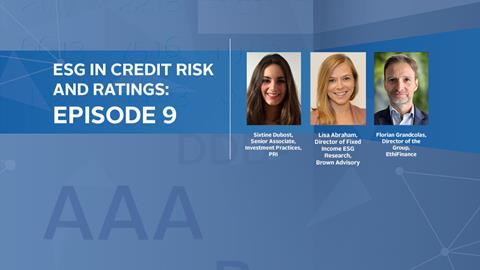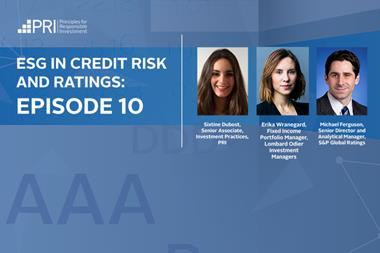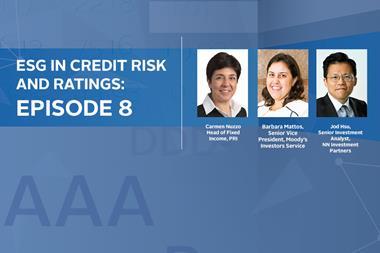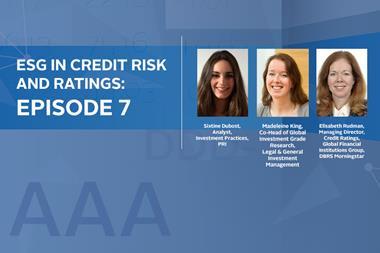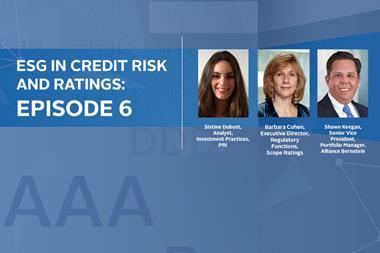ESG IN CREDIT RISK AND RATINGS: EPISODE 9
With Sixtine Dubost, Senior associate, Investment practices, PRI, Lisa Abraham, Director of Fixed Income ESG research, Brown Advisory and Florian Grandcolas, Director of the Group, Ethifinance
Note: The Principles for Responsible Investment podcast is designed to be heard. If you are unable to do this, this transcript offers an insight into the episode.
Transcripts are generated using a combination of speech recognition software and human transcribers, and may contain the occasional error. Please check the corresponding audio before quoting in print.
Subscribe to the channel via Apple podcasts, Spotify, or wherever you listen to your podcasts.
Sixtine Dubost
Welcome to the PRI podcast and the latest episode in our ESG in credit risk and rating series. My name Sixtine Dubost. I’m a Senior Associate in the Investment Practices team at the PRI. And I’m delighted to be your host today.
We have been warned, only the most drastic cuts in greenhouse gas emissions within the next two decades would prevent an environmental and social disaster. According to the latest report from the IPCC, the intake of environmental panel on climate change. As part of the global effort to address urgent issue of climate change reporting against the Task force on climate related financial disclosures or TCFD has become mandatory in the UK on the 6th of April of this year. Since its launch in 2015, a lot of attention has been given to the companies disclosing climate related financial data 2 and metrics, but less on the users of such information. This is why at PRI, we launched to survey for investors and create rating agencies to assess how they utilise these disclosures. And we published a note available on our website with the results and today to discuss the findings of the survey and dig a bit deeper. I’m joined by Lisa Abraham, Director of Fixed income ESG research at brown advisory and Florian Grandcolas, Director of the Ethifinance group.
So welcome to you both. And thank you for joining us today. One of the key conclusions of the survey was that credit analysts from both the investor and the credit rating agency sides are more and more recognising that climate related financial disclosure should be embedded in bond valuations. And also that climate change can impact issuers probability of default. So Lisa, as an investor, how have you started to incorporate TCFD related information in your own analysis?
Lisa Abraham
Thanks Sixtine. It it’s an excellent question. And I think climate risk is one of those ESG risks, kind of like governance. That is something that will impact essentially all businesses, whether that be physical climate risk of, where our company’s assets are located or transition risk associated with regulatory changes or shift in consumer demand. And we find that the TCFD framework are really helpful high-level framework that is applicable across a broad set of sector. So, the guidelines are fairly broad so that you can really hone in on what’s most material to the particular sector in question. And so how we use TCFD varies a little bit, depending on what company you’re looking at. I think a couple of examples come to mind. So, in the power utility sector, for instance, we’ve been doing a lot of work looking at utilities with exposure to California, and here we’re looking at wildfire risk, which, you know, it may obvious after the, the PG and E bankruptcy to look here.
But I, I think it’s a good example to show how it’s important to look at both physical and transition risk for California utilities in many ways, their, their ahead, in terms of their build out of renewables, you know, while we knew wildfires were risk, we’d ever or risk, we, we never thought that it would lead to a bankruptcy or we didn’t at the time. And so I think that really was a good lesson for us as investors to really hone in on these risks. And we are seeing that being priced into the market. Another area that we look at a lot is the semiconductor industry. Semiconductors are, are very water intensive in their manufacturing processes. And, you know, we’ve seen over the last year or so, the impacts of a, of a chip shortage within supply chains. And I think that can be exacerbated over time as water stress is more prevalent in, in a lot of these supply chains.
So there, we’re looking at how a semiconductor company is managing the water intensity, where are they located? Are they water, stress regions? And what are the short, medium and long term impacts of, of those of that water stress? And I think that time horizon piece is really important because I think what we learned with the PG and E bankruptcy as one implication is these climate risks are not that far off as, as I think we previously thought. And so it’s important, um, for companies to be following TCF D framework for thinking about what, what are the possible 3 scenarios that we should be taking into account and what are those short, medium and long term risks, and how are you, uh, evolving how you’re managing these risks as we learn more about climate change, because we’re all still learning about a lot of this together.
Sixtine Dubost
And now turn to you Florian, how are you using TCFD related information at Ethifinance?
Florian Grandcolas
Well, I think that’s very interesting that Lisa mentioned all these examples and, also that you mentioned, probability of default and it is through that for a credit rating agency. That’s what we’re aiming to measure, right? We’re trying to, to see if the probability of default is, is changing and all those examples that were just given show that indeed now the probability of default is very directly impacted by climate risks, whether they’re physical, whether they’re linked to transition. And we could also say in the TCFD framework type of things that, you know, it can be impacted positively by opportunities as well. You know, as far as we’re concerned, what we’re looking for is information. So there are different, I would say reporting frameworks of which TCFD is one, which is increasingly used in the American/English markets. And there are others in the European core European markets. What really matters is that we’re using this information at different levels in the analysis to identify the impact that it has on the probability of default. So, sector research will clearly include some elements of climate risks and therefore the information that is provided by the companies is extremely important. The companies themselves and their positioning versus these risks that exist in their sector is obviously also extremely important. So here, a simple example can be, you mentioned visa, the energy sector. I could mention other sectors like the auto sector, which has been heavily impacted by new regulation, which is coming linked to emissions auto emissions, which is linked to, to climate as well. The transportation sector obviously is heavily impacted by that. And so the positioning of companies is extremely important and we’re trying to, to also be, um, forward looking and therefore we’re starting to compute carbon earnings at risk, which also helps us to look at what is the potential risk that these companies are faced with in terms of their profitability, depending on the, we say carbon price that we can estimate for their sector and for themselves.
Sixtine Dubost
So you mentioned the issue of a sector analysis and as a follow up question for Florian and to keep the focus on the credit rating agencies for a moment, which are the metrics and targets specifically analysts look at to inform their credit risk assessments.
Florian Grandcolas
Yeah, there are, there are really different levels of information that we’re looking for. In terms of metrics, the usual metrics, I would say scope one and scope two is the very basic and intensity 4 calculated to compare with other companies. But also we’re looking to, we’re going to look sorry at the governance obviously, and whether there’s a number of policies which have been put in place to manage these climate risks. And, and here you were mentioning, TCFD is asking for this type of information. So is the NFRD regulation in Europe because you have to have that type of information. When you’re looking at a company, it’s not just a reporting numbers, but really what the company is doing about it. And of course, if you’re trying to estimate the probability of default, you want to be again forward looking, you also have to look at what the companies are doing to be aligned with the Paris agreement, and the two-degree scenario. And so that’s all that type of information if it is reported. And if it is reported in a standardized standardised way is obviously very helpful for the analysis. And again, it’s very real, it’s really about company’s risk’s life and future company’s profitability and defaults.
Sixtine Dubost
So very material indeed. And, and what about you Lisa, the investor side? What are the relevant metrics and targets that can inform investment decisions?
Lisa Abraham
Yeah, I would echo a lot of what Florian said there. I think a lot of ESG analysis is inherently more qualitative, but climate is one of those areas where we can get more quantitative data. And it’s a mix of where, where our company is today, but also where they’re going, looking at some of those forward looking metrics as well. Florian mentioned emission scope, one, two, and three. What targets do they have in place? Ideally, we like to see targets aligned with the 1.5 degree scenario and approved by the science based target initiative. That’s a way for us to, to ensure credibility of the targets. I mentioned semiconductors earlier there, we might be looking at water intensity or water recycling rates, and then to some of the points Florian made as well. We want to understand the financial implications. So how can we quantify that data in financial terms, looking at the impacts on revenues from increasing demand for climate solutions or cost savings from energy efficiency improvements.
We also want to look at capital allocation plans. How much are they investing in, in their long term resilience? So within the power utility sector, how much are they investing in their renewable energy build out, but then also how much are they investing in hardening their infrastructure to better withstand that physical climate risk? And then all of that quantitative data, um, we supplement with a qualitative assessment again, looking at, um, how they expect to achieve their targets. What’s the upside or downside of their, uh, ability to achieve or, or not achieve those targets who is running the strategy and how are they adjusting and adapting that strategy over time. So, all of that’s really important to us then being able to work with the credit analysts to understand how we can weave that information into their traditional credit models.
Sixtine Dubost
You say, you mentioned the, the work that you’re doing with the power utility sector and the semiconductors. So to go, to go back a bit to this engagement point, do you use the TCFD framework as a way to engage with the company doing investing? And if so, how are you doing that exactly?
Lisa Abraham
Yeah, absolutely. The, the TCFD framework is really a really helpful way to, to structure engagement conversations, you know, governance, strategy, metrics, and targets. So you want to know on the governance piece who is responsible for setting the climate strategy, you want to understand what is that strategy, and then what KPIs or metrics are they using to track their ability to, to execute on that strategy? So one example shifting to, to another sector, the aviation sector, there’s a small regional airline that we invested in about a year and a half ago, and they not only are susceptible to the transition risk or decarbonisation. That’s key to the aviation sector as a whole, but they’re also located in an area that’s highly susceptible to physical climate risk and in an economy that’s highly reliant on tourism, which as we see the increasing impacts of climate change, that could impact the number of tourists that are actually visiting this region.
And so we had seen a little bit of information on how they were improving their fuel efficiency over time, but they lacked a concrete climate strategy that was externally available. So, we immediately got on the phone with them and initiated an engagement and have continued to have routine conversations with them over time. And what we found, and this is true for a lot of smaller companies that may not have the same resources as larger companies to disclose, you know, a hundred page sustainability report is that these were issues that they were thinking about, but they were working through the right reporting framework. So, we talked to them about TCFD. We introduced them to CDP, which provides a voluntary questionnaire for companies to respond to that’s aligned with TCFD. So, it’s not that CDP is a completely separate reporting framework, but it’s a way for them to start reporting in line with TCFD.
And we found over the last year that one, they reported to CDP for the first time outlining some of these climate related risks and opportunities. They created a new role within the company. That’s completely focused on, um, their sustainable strategy. They didn’t have this position before and they expect to release a more robust TCFD report, this year that that’s going a little aired deeper than, than their initial CDP report. So, I think anytime that we’re on the phone with, with a company climate often comes up, as I mentioned, it’s applicable to most sectors. And I think TCFD is an area that we spend a lot of time talking about as, as a framework that they can use to start thinking about it internally. The one other thing I’d mention on engagement is the power of collaborative engagements in this space. So, we’re part of Climate Action 100 +. And then we also do a lot of work with CDP on, on some of their collaborative engagement work as well. They have their annual nondisclosure campaign. So a number of investors can sign on to a letter to encourage companies to 6 disclose for the first time. And obviously many investor voices is, is much more powerful than one. So we use those opportunities to enhance our engagements as well.
Sixtine Dubost
Florian, do you agree with Lisa on the importance of a using TCFD framework as a way to engage with companies.
Florian Grandcolas
Yes, of course. And I, I think any, anything is good to engage with the companies on this topic. And, what we find is that, I mean, we’re dealing, being EthiFinance, we’re dealing a lot with. I would say meat camps in Europe, and they sometimes are aware of TCFD. Sometimes they are not, what is really important is to show them that actually some standards exist and that we need that information because as we just discussed before, it is something that is going to influence the rating and actually it already has had, I mean, climate actions or, or views on climate has already had some impact on ratings. So, to explain to them the importance of that, showing a framework such as TCFD is actually always very useful because it shows them that there are norms and that there are ways that they can actually report and adapt to which already exist. And so that it’s not something which is completely also in the air or which is a new or crazy demand from a rating agency. It’s actually something that’s very real used and asked by the market and by investors. So I think that’s important. And, and again, if you tell them that actually, you know, some companies have been looked at through the prison of the climate risk and that it has influenced the rating, then suddenly they look at you in another eye. And, you know, we’ve had the case like this of, uh, a company, for example, in the entire manufacturing industry where we actually, it’s not that we downgraded it, but when we actually rated them, we took into consideration the fact that their positioning was heavily reliant on large SUVs, for example, and that there was clearly a key question as to the, I would say, durability of this business model in a world where clearly we need to pollute less, you know, that’s the type of things we can use TCFD for.
Sixtine Dubost
Thanks a lot, both for your, for these practical examples, which of engagement, which I’m sure many of our signature will, uh, will find helpful. And Lisa, to your point about a collaborative engagement at PRI, we really value this type of engagement, Climate Action 100 +, which you mentioned is an initiative run by the PRI. We think that it’s a great way to bring voices to, uh, smaller investors, which have less of influential power by, uh, getting all together and, uh, and getting hurt. Now, moving on to geographical considerations, Florian Ethifinance is a European group. So what are your views on TCFD as a regulatory framework in comparison with the other existing European ones?
Florian Grandcolas
That’s an interesting question. Well, TCFD is, is not regulatory. It’s a self-built initiative, which is coming also from, I would say the private world. And it’s very typical of what would come from, the US and the UK and as such, it is actually also extremely useful, of course, in Europe there, that tends to be a different approach, which is more top down and public approach, which is for that matter regulatory. And that’s what we have. We have what has been called the NFRD until now. And there’s a new version, which is coming, which is about the corporate sustainability reporting. So CSRD in the next few years, which is giving guidelines as well as to how companies and which companies should report and that’s going to be compulsory. So, there’s an element which is good in that of climate reporting and also other type of sustainability reporting. So the two initiatives, as far as I’m concerned, you know, I’d rather have two than have none and, and even if they come from different cultures and different angles, I think they’re both very useful in, in the way that we work, because some companies are going to use, and especially the American and UK companies are going to use TCFD, which is fine. And some more European like companies are going to use, especially on the midcap side, are going to use the regulatory compliance reporting. And that’s fine as well, even if they’re not always exactly reporting in the same ways. There are a lot of common things in there, including the risk identifications, the governance, um, the targets and the objectives. And, and that is basically what we need to be able to analyse. So both frameworks are really useful, but of course they’re coming from different angles top down versus bottom up.
Sixtine Dubost
So we’ve, we’ve covered a lot of ground on the TCFD framework, how the disclosures are incorporated in create risk assessments and how they can inform investors decisions and create ratings. We talked about engagement as well, but now final question from me to you is what would you like to see improving in this framework? What, what is missing basically, Lisa, if you wanna start.
Lisa Abraham
Yeah. So I would say two things. I think, of course, we, we always wanna see greater standardisation across sectors. And I think we, when we talk to companies, we talk about how TCFD and SAS can be used together so that you can really hone in on, on those metrics that are most important to that specific sector. Again, TCFD is, is this high level guideline. And I think that gets to, to my next point is we think that the TCFD framework could be useful across other asset classes beyond corporate. So, within the municipal space, as well as sovereign bonds, climate risk is just as big, if not more of a risk there. Just as climate change will require the entire restructuring of business models. So to will it require the, um, restructuring of entire economies. So, that’s an area where we would really love to see a TCFD, like framework applied to those asset classes as well. And I know PRI’s doing some work here as well as CDP. And so that’s, that’s a conversation that we’re very engaged in as well.
Sixtine Dubost
What about you Florian? What are your asks?
Florian Grandcolas
Um, well, I, I concur with Lisa’s really, I mean, more standardisation and other asset classes is really something that’s needed. I mean, we need to have some climate reporting in everything we do today, so that’s just a must have in the future. So I’m happy to see that investors are really pushing for this too. and we’re on common grounds here. Um, I guess what we, what we see is obviously that TCFD is very much linked to financial materiality. Um, and here, maybe I’m putting a little bit, my double hat given that I’m heading both an ESG and a rating agency, but I think it’s important to think about what we call the double materiality, IE, make sure that we measure the, the real impact of the companies on the climate and not just vice versa. Clearly, it’s a European approach. Um, the European regulatory environment is going to push for this. We need to really understand how companies impact climate to see how it will actually revert on themselves, uh, in a financial materiality way. So actually double materiality is linked to simple materiality, but we really need to measure the impact of companies on planet and actually on other sustainable issues.
Sixtine Dubost
So, I have noted down increased standardisation extension to other asset classes in the incorporation of double materiality concept. I think now that this brings us to the end of our conversation.
So, thank you very much Lisa and Florian for sharing your experience and for this, very insightful conversation. A reminder that this podcast series is part of a project called the ESG in the credit risk and ratings initiative, which Brown advisory and Ethifinance are supporting along with 26, other credit rating agencies and 175 investors. And you can find all resources that we have produced so far on your unpri.org/credit-ratings, where there is also a statement of support if we would like to join if you’re not part of it yet. So, thank you very much for listening, and don’t forget to tune in for our next podcast. And until then, goodbye.
Downloads
The Principles for Responsible Investment podcast transcript
PDF, Size 0.2 mb


